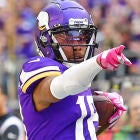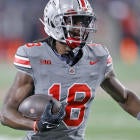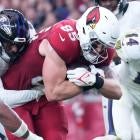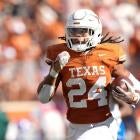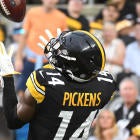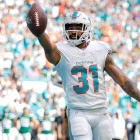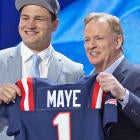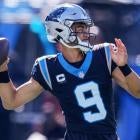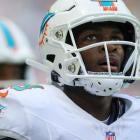
In yesterday's newsletter, I talked about how we're likely on the verge of a changing of the guard at the running back position, and that seems true for wide receiver, too. Though you may not want to tell the older guys at this position that they're supposed to be stepping aside for the next generation.
Among the top 12 at the position last season, five were 28 or older – with Tyreek Hill (second), Davante Adams (third), and Amari Cooper (11th) doing it despite changing teams last offseason, something that's supposed to make a wide receivers' life a lot harder. And heck, let's throw a 30-year-old DeAndre Hopkins in there – he was 10th in receiving yards per game despite playing just five games with Kyler Murray.
Those guys aren't just moving aside, and it makes it kind of tricky to rank wide receivers. The age cliff isn't as severe for wide receivers as it is for running backs, but they tend to peak around 26-28, and tend to fall off after that, and a bunch of the high-end guys are in that danger zone now. Hill, Adams, Hopkins, and the rest have managed to avoid it so far, but you have to bake in at least a little bit of risk when projecting them.
But if they continue rolling along, they could be some of the best early-round values around. We went through the QB rankings Tuesday and the RB rankings yesterday, now let's take a look at how WR shakes out after the NFL Draft:
WR Rankings Update
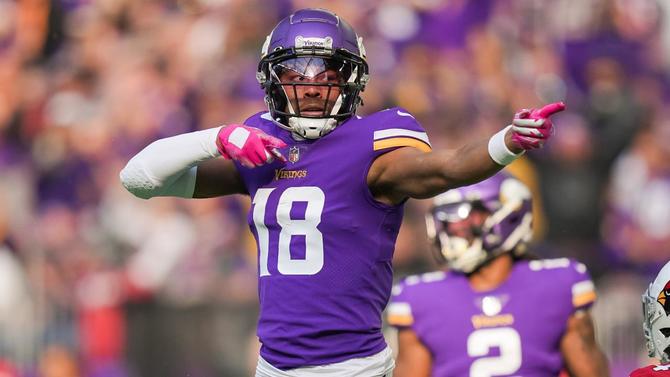
Let's start with how Jamey Eisenberg, Dave Richard, and Heath Cummings are ranking the position:
Consensus Rankings

The consensus has Justin Jefferson at the top, but that word is kind of a lie. Because Heath actually has Ja'Marr Chase ranked as his No. 1 WR and No. 1 overall player for the 2023 season. I'm sure Heath will write about it plenty over the summer as we prepare for the season, but I simply had to text him and get an explanation. Here's what he had to say:
"They're basically tied in my projections. I think a Jordan Addison and a full season of T.J. Hockenson probably means Chase has a target edge, and I expected at least marginal efficiency bounce back from Chase's mediocre yards per target in 2022. Slight lean to the better quarterback and better offense."
I don't agree – Chase is actually my WR3, behind Cooper Kupp, who was actually the No. 1 WR and averaged 25.0 PPR points per game if you take out the one he left early with an injury – but I think the thought process behind it is interesting. Chase was historically efficient as a rookie and then turned into more of a high-volume guy in Year 2 as the Bengals struggled at times to take the top off the defense. If he combines the higher volume with the efficiency, he could break Fantasy Football.
I don't think you can really go wrong with any of those three, and Tyreek Hill might even belong in that conversation too – in the full games Tua Tagovailoa played last season, Hill was on pace for 123 catches, 1,841 yards, and nine touchdowns. He had a 70% catch rate last season with an average depth of target of 12.4 yards, while the median ADoT for 70% catch rate seasons over the past decade was 7.32. The Dolphins offense might not be able to recapture their 2022 magic, which is why we're projecting some regression for Hill, but what he did last season was No. 1 overall worthy.
I think there's probably a small tier drop between Hill and Diggs, though that's certainly a knock on Diggs, who has put up 19.8 PPR points per game in two of three seasons in Buffalo. He'll turn 30 this season but has no real competition for the top spot in the hierarchy in Buffalo. He's a viable first-round pick and a strong WR1 for any team.
CeeDee Lamb is the consensus No. 6 guy, and Heath actually has him ahead of Diggs. I'm just a teeny tiny bit lower on him, though not necessarily because of anything Lamb does wrong – he established himself as a clear Alpha No. 1 WR last season with little help in the passing game to take defensive attention. My concern here is mostly about the change from Kellen Moore calling plays to Mike McCarthy – as I pointed out in Tuesday's newsletter, the Cowboys have been top two in offensive pace over the past three seasons, while McCarthy's Packers were in the bottom 13 in each of his final three seasons as head coach. I think the pie is going to be smaller in Dallas, and Brandin Cooks represents a bit more competition for targets.
Lamb is my No. 7 WR, so I'm not too much lower on him than the consensus, but I do have Davante Adams ahead of him. It's fair to wonder how Adams is going to fit with Jimmy Garoppolo, who has been hesitant to throw the ball down the field in his time in San Francisco. Of course, there were questions about how Adams was going to fit with Derek Carr a year ago and he was just about as good as he always was – and he even had 226 yards on 12 catches with two touchdowns in two games with Jarrett Stidham at QB. Adams turns 31 in December, but we just haven't really seen any decline in his skill set yet, so I'm not expecting much of one.
There's probably another little drop between Adams and No. 8, Amon-Ra St. Brown. St. Brown is a PPR star, and with Jameson Williams suspended for the first six games of the season, the chances of St. Brown losing his spot as the top option in the passing game are even slimmer than they otherwise would have been. St. Brown is kind of the new-era Keenan Allen, in that he's a strong WR1 in PPR, but probably doesn't have as much upside as some other players drafted in his range. That being said, if you take out the two games in Weeks 5 and 7 when he was clearly less than 100% with an ankle injury and had just five catches for 22 yards, he averaged 18.6 PPR points per game, just ahead of A.J. Brown for the No. 7 spot last season. He's a pretty excellent player.
So is A.J. Brown, who I think represents the end of the true WR1 tier. The math whizzes among you may recognize that we have only talked about nine WR so far, so unless you play in a nine-team league, that means I think there are probably fewer true WR1s than teams in a league. The good news is, the next tier is super wide, with a bigger gap in my projections between Brown and WR10 (Garrett Wilson) than between WR10 and WR20. Getting at least one of these high-end WRs is a big priority for me, and if I could have two of them, that would be ideal – of course, I also want an early-round QB and would love to have Travis Kelce, so it's not exactly easy. This might be a good year for a zero-RB build, something I've mentioned a few times in this newsletter this offseason.
Wilson is, of course, talented enough to crash the top tier for good. As a 22-year-old catching passes from a pretty awful collection of quarterbacks, he had 83 catches for 1,103 yards and four touchdowns as a rookie. Whatever you think of Aaron Rodgers, he's sure to be an upgrade on the Zach Wilson/Joe Flacco/Mike White/Chris Streveler combination. The only question is whether Wilson can establish himself quickly as Rodgers' go-to option. He's a low-end WR1 with massive upside, though I'm also not 100% convinced he's a better player than Chris Olave, who is ranked five spots lower.
I skipped over Jaylen Waddle in the consensus rankings, because I've got him a few spots lower in my own rankings. That's not a knock on him, it's just that, like Tee Higgins (and DeVonta Smith, WR13 in the consensus rankings), he's the No. 2 option in his own offense, so it's not clear if he has the path to that elite tier. I think all three of those players are certainly talented enough to do it, and for what it's worth, I think Waddle is probably the best player of the group – I love any player who shows they can thrive in wildly different roles, as Waddle did in emerging as an unstoppable deep threat after being limited to being used as a high-volume, quick-hitter in the RPO game as a rookie. If Hill slows down or gets hurt, Waddle looks more than capable of emerging as a true No. 1 receiver for Miami. He can do it all.
Here's what the No. 2 range at WR looks like in the consensus ranks:

And it's worth pointing out that, when you look at the overall ranks, there's a significant drop after Smith:
13. DeVonta Smith, PHI -- OVR: 23
14. Chris Olave, NO -- OVR: 32
15. DeAndre Hopkins, ARI -- OVR: 37
16. D.J. Moore, CHI -- OVR: 41
17. Keenan Allen, LAC -- OVR: 42
18. DK Metcalf, SEA -- OVR: 43
19. Christian Watson, GB -- OVR: 44
20. Calvin Ridley, JAX -- OVR: 45
21. Amari Cooper, CLE -- OVR: 47
22. Deebo Samuel, SF -- OVR: 49
23. Drake London, ATL -- OVR: 53
24. Jerry Jeudy, DEN -- OVR: 55
As I said earlier, I think the dropoff comes earlier than this, after St. Brown, my WR9, so this tier is all pretty similar in my projections – I've got them all between 13.5 and 15.5 PPR points per game, more or less. That's not to say they're all the same – Olave, Watson, and London are all entering Year 2 with big breakout potential, so I think it makes sense to rank them ahead of where I have them projected, and I do.
I also think Hopkins might be the best value in that group. There's plenty of risk here, between his age and recent history of hamstring injuries plus the questionable QB situation in Arizona, with Kyler Murray's Week 1 status very much up in the air coming off a torn ACL. Hopkins was a lot less productive without Murray, dropping from 21.1 PPR points to 13.6 without him, but there's also still the potential for a trade to a better situation to account for. If Murray is ready for the start of the season, Hopkins could end up being a WR1.
Olave is one player I want to rank even higher than I do, but I'm kind of a coward. He's WR18 for me, but I think the skill set is so intriguing. His 14.2 yard average depth of target was the highest for any player who had a target share over 20%, and he was at 25% as a rookie. The Saints making adding Derek Carr such a priority indicates they think he's a big upgrade, so it's reasonable to think they'll rank higher than 27th in pass attempts this season. If that happens, Olave could take a big step forward, and it's not at all unreasonable to think he could break into the top 12 at the position.
One player I'm significantly lower on than this consensus is D.J. Moore. It's not that I don't like him. Quite the opposite in fact – he's got that same "thrived in different roles" thing Waddle has shown, and from a pure talent level, I might be higher on him than anyone in the FFT group (besides Heath, of course). The problem is the landing spot in Chicago. Yes, the decision to acquire Moore should lead to more passing from the Bears, who threw a league-low 377 times last season. They'll top that mark this season, for sure.
But even a 100-pass attempt jump would still make this a bottom-five pass volume team, in all likelihood. Even giving Moore a 25% target share at 477 targets gets him to just 120 targets, and while it's certainly not impossible that he ends up being a high-end WR2 with that many targets, he'll have to be a lot better than he's been on a per-target basis over the past couple of seasons, as he's averaged just 7.3 yards per target in that span. I'm a fan of Fields', but he's been a pretty poor passer so far, and I still think it's likely going to be at least a bit of a struggle. Moore should help the Bears offense a lot, but if I want to bet on that impact being felt, I'd rather do it by drafting Fields than investing a fourth-round pick in Moore.
If you want a really good breakdown of why Moore doesn't really make sense at this price, I highly recommend checking out old friend Ben Gretch's Stealing Signals newsletter from last week, "Drafters aren't adequately learning from 2022." Moore is one big-name player where I differ from my colleagues, because he's down at WR28 for me.
The other player from this group I'm notably lower on is Christian Watson, who is WR25 for me, though I'll point out again that I think the tiers at WR get awfully wide outside of the top 10 or so. Watson was a big-play machine as a rookie, topping 100 yards from scrimmage four times in his final eight games despite never having more than seven touches in a game. He scored eight touchdowns in those eight games, though all of them came in a four-game stretch from Weeks 10 through 13; he didn't have any touchdowns in his final four games.
That big-play ability may just be what makes Watson special, the same way someone like A.J. Brown's small-sample size dominance as a rookie was just the start of his emergence as an elite Fantasy option. Of course, Brown averaged 12.5 yards per target on 84 targets as a 22-year-old, while Watson was at 9.3 on 66 targets as a 23-year-old, so the comp doesn't quite work there.
Watson showed some really intriguing skills as a rookie, both with his ability to get open down the field and make plays with the ball in his hands. But he's playing with a new, unproven QB in Jordan Love, and he wasn't so overwhelmingly dominant as a rookie that you can just pencil him in as a superstar just yet – statistically, there wasn't that much room between Watson and Jahan Dotson, who ranks significantly lower, as Heath pointed out on Twitter this week. I like Watson, but not as my WR2.
I'm already 2400 words in and I haven't even gotten to the WR3 group, but there are so many interesting players at this position, so I'll try to be a bit more brief from this point on – we've got about three months before draft season really kicks off, this is certainly not my last opportunity to write about these guys.
Calvin Ridley is one of the most fascinating players in the pool this season. He'll turn 29 in December and really only has one elite season to his name, back in 2020, when he caught 90 passes for 1,374 yards and nine touchdowns. He was a big disappointment in 2021, then was away from the team after just five games, and was then suspended for the entirety of last season after being caught betting on games during the 2021 season. There's not a lot to go on here, but we have seen Ridley play like an elite receiver before, and now he's expected to be the No. 1 option with an ascending Trevor Lawrence. Christian Kirk had a fine 2022, but he's nowhere close to what Ridley showed at his best.
But how much can we really expect from a guy who will be nearly 22 months removed from his last game when he steps on the field in Week 1? Ridley is already at the age where most receivers start to decline, and we haven't seen him play at a high level since 2020. He's got a new team, with a QB we think is very talented, but he hasn't yet put together a season that rises much beyond "pretty good." Is Ridley still a No. 1 WR? Is Lawrence actually an elite QB? I'm bullish, ranking Ridley WR17, but there's a lot of risk.
Here are the consensus No. 3 WRs:

There's one thing you've surely noticed here that I want to hit on before I'm finished: Only one rookie in the top 36. This wasn't considered an especially great class for rookie wide receivers, and the landing spots for the first-rounders were especially not ideal. Jordan Addison is the lone exception as a guy I think could emerge rather quickly as the No. 2 option in Minnesota, and I'm fine drafting him as a WR3 or (preferably) as a Flex option.
Zay Flowers (WR46), Quentin Johnston (WR48), and Jaxon Smith-Njigba (WR55) are all worth drafting, as are the likes of Jonathan Mingo, Jayden Reed, Rashee Rice, and Marvin Mims, but you'll probably have to be more patient with them. Don't draft them and cut them if they aren't producing in Week 1 – just go in knowing it might be more like October or November before they're making an impact.
Chris' WR Rankings
- Justin Jefferson
- Cooper Kupp
- Ja'Marr Chase
- Tyreek Hill
- Stefon Diggs
- Davante Adams
- CeeDee Lamb
- A.J. Brown
- Amon-Ra St. Brown
- Garrett Wilson
- DeAndre Hopkins
- DK Metcalf
- Tee Higgins
- Devonta Smith
- Jaylen Waddle
- Keenan Allen
- Calvin Ridley
- Chris Olave
- Deebo Samuel
- Amari Cooper
- Chris Godwin
- Terry McLaurin
- Tyler Lockett
- Michael Pittman
- Christian Watson
- Mike Williams
- Drake London
- D.J. Moore
- Marquise Brown
- Jerry Jeudy
- Brandon Aiyuk
- JuJu Smith-Schuster
- Jordan Addison
- Christian Kirk
- Mike Evans
- Jahan Dotson
- Kadarius Toney
- Diontae Johnson
- Brandin Cooks
- George Pickens
- Michael Thomas
- Treylon Burks
- Courtland Sutton
- Adam Thielen
- Zay Jones
- Allen Lazard
- Rondale Moore
- Gabe Davis
- Jakobi Meyers
- Jaxon Smith-Njigba
- Elijah Moore
- Tyler Boyd
- Skyy Moore
- Romeo Doubs
- Marquez Valdes-Scantling
- Jameson Williams
- Rashod Bateman
- Mecole Hardman
- Odell Beckham
- John Metchie













